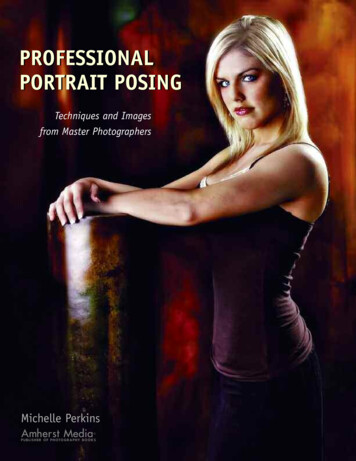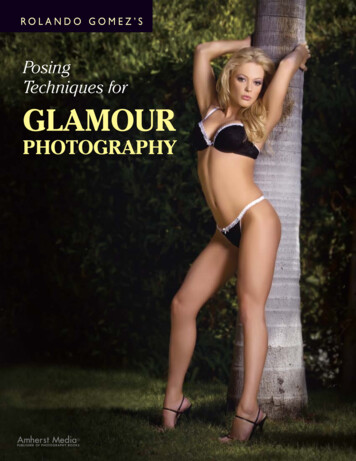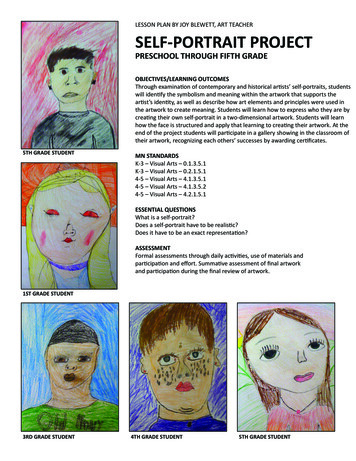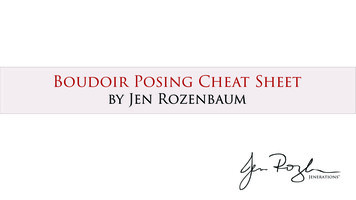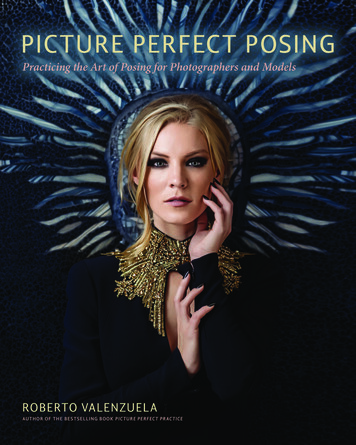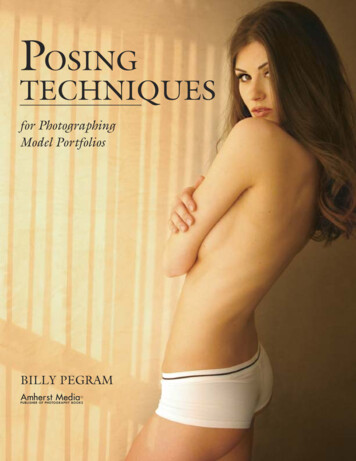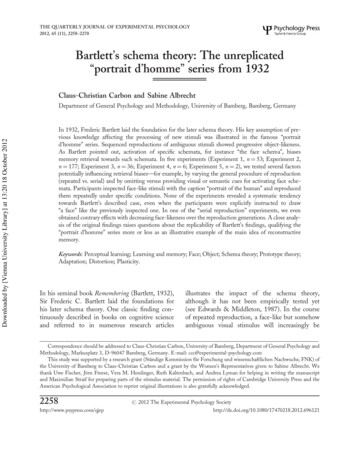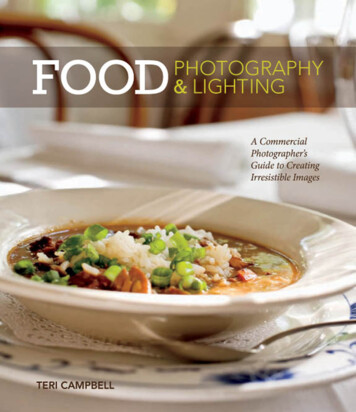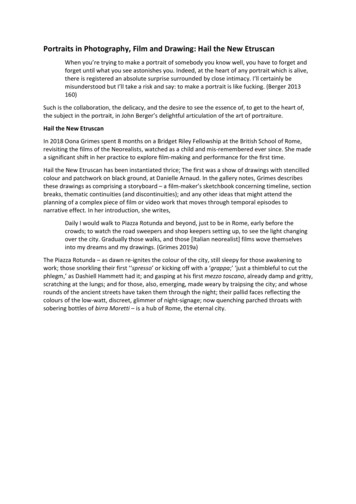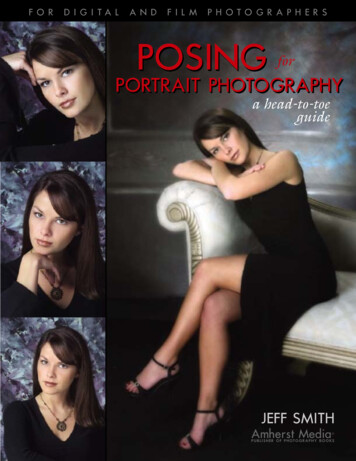
Transcription
F O RD I G I TA LA N DF I L MP H OTO G R A P H E R SPOSING forPORTRAIT PHOTOGRAPHYa head-to-toeguideJEFF SMITHAmherst Media P U B L I S H E R O F P H OTO G R A P H Y B O O K S
Copyright 2004 by Jeff Smith.All rights reserved.Published by:Amherst Media, Inc.P.O. Box 586Buffalo, N.Y. 14226Fax: 716-874-4508www.AmherstMedia.comPublisher: Craig AlesseSenior Editor/Production Manager: Michelle PerkinsAssistant Editor: Barbara A. Lynch-JohntISBN: 1-58428-134-9Library of Congress Card Catalog Number: 2003112490Printed in Korea.10 9 8 7 6 5 4 3 2 1No part of this publication may be reproduced, stored, or transmitted in any form or by any means, electronic,mechanical, photocopied, recorded or otherwise, without prior written consent from the publisher.Notice of Disclaimer: The information contained in this book is based on the author’s experience and opinions.The author and publisher will not be held liable for the use or misuse of the information in this book.
TABLE OF CONTENTSINTRODUCTION . . . . . . . . . . . . . . . . . . . . . .6Salable Posing . . . . . . . . . . . . . . . . . . . . . . . . .6Obstacles to Salable Posing . . . . . . . . . . . .6The Client Knows Best . . . . . . . . . . . . . .10Learning Posing . . . . . . . . . . . . . . . . . . . . . .11Show, Don’t Tell . . . . . . . . . . . . . . . . . . .12Update Your Pose Book . . . . . . . . . . . . .12About This Book . . . . . . . . . . . . . . . . . . . . .131. SIX THINGSYOU SHOULD NEVER DO . . . . . . . . . . . . .15Number One: The Angle of the Face . . . . . .16Number Two: The Shoulders,Waist, and Hips . . . . . . . . . . . . . . . . .17Number Three: The Arms . . . . . . . . . . . . . . .18Number Four: Lower the Chin,Lose the Catchlights . . . . . . . . . . . . .18Number Five: The Spine and Shoulders . . . .19Number Six: Your Expression . . . . . . . . . . . .20An Additional Factor:The Tilt of the Head . . . . . . . . . . . . .222. DEFINING THE POSETypes of Poses . . . . . . . . . . . . . . . . . . . . . . .24Traditional Posing . . . . . . . . . . . . . . . . . .24Casual Posing . . . . . . . . . . . . . . . . . . . . .25Journalistic Posing . . . . . . . . . . . . . . . . .27Glamorous Posing . . . . . . . . . . . . . . . . . .27Settings, Clothing, and Posing . . . . . . . . . . .29Settings . . . . . . . . . . . . . . . . . . . . . . . . . .30Taking Your Cue from Clothing . . . . . . .33Capturing the “Real” Person . . . . . . . . . . . .34TABLE OF CONTENTS3
4. POSING THE SHOULDERS,ARMS, AND HANDS . . . . . . . . . . . . . .51Triangular Composition . . . . . . . . . . . . . . . .52The Shoulders . . . . . . . . . . . . . . . . . . . . . . .56Arms . . . . . . . . . . . . . . . . . . . . . . . . . . . . .57Long Sleeves . . . . . . . . . . . . . . . . . . . . . .57Don’t Rely on Digital Fixes . . . . . . . . . . .57Explaining Problems with Tact . . . . . . . .59Posing the Arms . . . . . . . . . . . . . . . . . . .60Using the Arms to Conceal Problems . . .61Observe the Details . . . . . . . . . . . . . . . . .61The Hands . . . . . . . . . . . . . . . . . . . . . . . . . .63Bend Every Joint? . . . . . . . . . . . . . . . . . .63Give Them Something to Hold . . . . . . . .64Before Moving On tothe Full-Length Poses . . . . . . . . . . . . . . .655. THE BUSTLINE ANDTHE WAISTLINE . . . . . . . . . . . . . . . . . . .683. POSING THE FACE . . . . . . . . . . . . . . . . .35The Connection to Lighting . . . . . . . . . . . . .35Light from Below . . . . . . . . . . . . . . . . . .35Consistency . . . . . . . . . . . . . . . . . . . . . . .36Hardness or Softness of the Source . . . . .36The Eyes . . . . . . . . . . . . . . . . . . . . . . . . . . . .38Catchlights . . . . . . . . . . . . . . . . . . . . . . .38Position of the Eyes . . . . . . . . . . . . . . . .41Eye Contact . . . . . . . . . . . . . . . . . . . . . .43Reflective Poses and Profiles . . . . . . . . . . . . .46Eyes Follow the Nose . . . . . . . . . . . . . . .46One Eye or Two . . . . . . . . . . . . . . . . . . .46Lighting . . . . . . . . . . . . . . . . . . . . . . . . .46The Tilt . . . . . . . . . . . . . . . . . . . . . . . . . . . .46The Traditional Rules . . . . . . . . . . . . . . .46The Real Rule . . . . . . . . . . . . . . . . . . . . .47Hair . . . . . . . . . . . . . . . . . . . . . . . . . . . .47Guys . . . . . . . . . . . . . . . . . . . . . . . . . . . .48The Neck . . . . . . . . . . . . . . . . . . . . . . . . . . .494POSING FOR PORTRAIT PHOTOGRAPHYEnhance or Conceal? . . . . . . . . . . . . . . . . . .68Lighting and Posing . . . . . . . . . . . . . . . .70The Waistline . . . . . . . . . . . . . . . . . . . . . . . .71Angle to the Camera . . . . . . . . . . . . . . . .71Seated Subjects . . . . . . . . . . . . . . . . . . . .71The Emotional Factors . . . . . . . . . . . . . . . . .72Technical Skills vs. People Skills . . . . . . . .72Interpreting Emotions . . . . . . . . . . . . . . .74Lasting Value . . . . . . . . . . . . . . . . . . . . .766. HIPS AND THIGHS . . . . . . . . . . . . . . . .78Avoiding Full-Length Poses . . . . . . . . . . . . .78Slimming the Hips and Thighs . . . . . . . . . . .79Standing Poses . . . . . . . . . . . . . . . . . . . .79Seated Poses . . . . . . . . . . . . . . . . . . . . . .80Look for Obstructions . . . . . . . . . . . . . . . . .82In the Studio . . . . . . . . . . . . . . . . . . . . . .82Outdoors . . . . . . . . . . . . . . . . . . . . . . . .83Groups . . . . . . . . . . . . . . . . . . . . . . . . . .84Purpose of the Portrait . . . . . . . . . . . . . . . . .85Unusual Poses . . . . . . . . . . . . . . . . . . . . . . . .87Our Changing Bodies . . . . . . . . . . . . . . . . . .88
7. THE FEET AND LEGS . . . . . . . . . . . . . . .89Feet . . . . . . . . . . . . . . . . . . . . . . . . . . . . . . .89Bare Feet . . . . . . . . . . . . . . . . . . . . . . . .90Minimizing the Apparent Size . . . . . . . . .90Posing the Toes . . . . . . . . . . . . . . . . . . . .91Shoe Selection . . . . . . . . . . . . . . . . . . . . .91Legs . . . . . . . . . . . . . . . . . . . . . . . . . . . . . . .94Ankles . . . . . . . . . . . . . . . . . . . . . . . . . . .94Muscle Tone . . . . . . . . . . . . . . . . . . . . . .94Color and Nylons . . . . . . . . . . . . . . . . . .95Getting New Ideas . . . . . . . . . . . . . . . . .96Leg Length . . . . . . . . . . . . . . . . . . . . . . .96Posing Techniques . . . . . . . . . . . . . . . . .97The “Deadly Sins” of Leg Posing . . . . . .998. BRINGING IT ALL TOGETHER . . . . . .101Pose Every Image asa Full-Length Portrait . . . . . . . . . . .101Analyze the Lines . . . . . . . . . . . . . . . . . . . .101Take Control . . . . . . . . . . . . . . . . . . . . . . .1039. POSING MULTIPLE CLIENTS . . . . . . . .109Proximity and Composition . . . . . . . . . . . .109Head Placement . . . . . . . . . . . . . . . . . . . . .110Start with the Core . . . . . . . . . . . . . . . . . . .111Your Best Work for Every Client . . . . . . . . .11110. VARIATIONS . . . . . . . . . . . . . . . . . . . .114Practicing with Variations . . . . . . . . . . . . . .114Demonstrating Variations . . . . . . . . . . . . . .119Keep Poses in Your Mind . . . . . . . . . . . . . .119Helping Your Client Relax . . . . . . . . . . . . .120IN CLOSING . . . . . . . . . . . . . . . . . . . . . . .121ABOUT THE AUTHOR . . . . . . . . . . . . . . .122INDEX . . . . . . . . . . . . . . . . . . . . . . . . . . . .123POSING FOR PORTRAIT PHOTOGRAPHY5
INTRODUCTIONThe human form. It can be shaped and proportioned to beone of the most beautiful subjects on earth. At the sametime, the body can be arranged in a such way that it makes even themost attractive person look disfigured.Further complicating this arrangement of the human form areall the different shapes and sizes of people that we, as professionalphotographers, must work with. It is one thing to make a perfectmodel look good during a test session or seminar—but use the sameposes on a good portion of our average customer base, and you willend up with an unsaleable portrait.So, what is it that makes one arrangement of body parts look sograceful, while another arrangement looks so awkward? That is thesubject of this book. But before we look at the mechanics of posing,there are a few other things to keep in mind if we hope to successfully work with our clients and sell our images. These are detailedbelow.Salable PosingSalable posing is much different than artistic posing. Show a largerwoman of today a portrait of a larger woman painted by one the oldmasters and she will say that it is art. Take a portrait of that samewoman of today in the exact same pose, and she will say she lookslike the Pillsbury Dough Boy. As you can see from this example, creating a salable pose is a complicated issue.Obstacles to Salable Posing. The first thing to understand isthat you must select a pose based on the needs and tastes of the indi6POSING FOR PORTRAIT PHOTOGRAPHYWhat is it that makes onearrangement of body partslook so graceful, while anotherarrangement looks so awkward?
In traditional posing, women were supposedto look passive. That just doesn’t suit thewomen of today.The greatest hurdle photographers must make is getting overthe “photographers know best”way of thinking.vidual client. This is completely the opposite of the way all of uslearn photography. We are taught that every detail of every portraitwe take should be selected to fit our taste and designed for our ownpurposes. The greatest hurdle photographers must make is gettingover the “photographers know best” way of thinking. Most photographers like to think of themselves as artists, free spirits who get tocreate little works of art—but someone else has to live with that“art.” And in the end, the client and their money will determine ifit is art or not! The truth is that art is in the eye of the buyer, notthe creator.Tradition is another old friend of photographers that must bedealt with. The outdated and obsolete theories of posing taught toyoung photographers as a start for learning classic art theory areINTRODUCTION7
Ideas about posing both men and womenhave changed since the era that inspired the“rules” of posing.hard to get past. It’s important to understand that classic posingtheories came from a different place and a much different time.Let’s take women for example. In the era that inspired much ofour posing theories of today, women were expected to be passiveand submissive. It was a man’s world, and men allowed women tolive in it so they could have babies and tend to the house. Lookaround. Do you see any passive, submissive women around today?(And you want “tended to?” Just leave the toilet seat up once andshe’ll give you “tended to!”) The point is, that the passive posing ofwomen that was all the rage hundreds of years ago, doesn’t reallyapply to the women of today.Women want to look like women, of course, but they don’t wantto look like docile creatures without a thought in their head. Ialways have this fight with my young photographers (fresh from thelocal college photography program) about the tilt of the head. Theyinsist that the head of a woman must be tilted in toward the higher8POSING FOR PORTRAIT PHOTOGRAPHYIn the era that inspired much ofour posing theories of today,women were expected to bepassive and submissive.
Women want to look like women, of course,but they also want to look confident andintelligent.shoulder. It isn’t until I show them how awkward that tilt can makesome women look in some poses that they start to understand whatI am trying to teach them.Believe it or not, guys have changed, too. We don’t kill our ownprey, we shower regularly (well, until the whole “grunge” thing withyounger people came along), we help raise our children, and we areallowed to be much less rigid and unemotional. This means youdon’t have to make every executive portrait of a man look as thoughhe has a stick up his backside. It’s alright to have Dad lean forwardor recline back slightly. He can even smile a little in a family portrait,so he actually looks like he is enjoying himself.That said, the first step in learning how to pose today’s client isto overlook what you have learned about the clients of yesterday.Notice I said overlook, not forget. It is important to understand classic posing, but once you understand it, move on. For any of youINTRODUCTION9
younger photographers who haven’t studied art theory, buy somebooks, go to some museums, enjoy the beauty in the work of thepast and look for ways to improve it for your clients’ work in thefuture.The Client Knows Best. As you can probably tell from theabove, it is usually the photographer’s frame of mind, not his or herlack of skill or ability, that becomes the biggest obstacle to creatingsalable portraits that have a sense of style. Talk to ten photographerson any given subject and every one of them will think that they havethe best way of handling the situation. However, we could all benefit by keeping in mind that we are in a creative profession and thereis not a single “best way.” The best way to do something is, quitesimply, the way that makes an individual client happy—and whatWe are in a creative professionand there is not a single“best way.”The best way to pose your client is the waythat makes them happy.10POSING FOR PORTRAIT PHOTOGRAPHY
Using sample photographs before the session starts can help you to clearly define thetype of portrait and posing the client has inmind.makes one client happy, will notnecessarily make another clienthappy.How to make clients happyis a subject that could easily fillan entire book, but the mosteffective way to start in thatdirection is to ask your clientswhat they want. Using samplephotographs before the sessionstarts can help you to clearlydefine the type of portrait andposing the client has in mind,and this will start you in theright direction.Talk with each client aboutthe areas of their body and facethat they feel they have problems with. And remember, wecreate a product that is so
poses on a good portion of our average customer base, and you will end up with an unsaleable portrait. So, what is it that makes one arrangement of body parts look so graceful, while another arrangement looks so awkward? That is the subject of this book. But before we look at the mechanics of posing, there are a few other things to keep in mind if we hope to success- fully work with our .File Size: 2MBPage Count: 128People also search forposing guide for photographersposing for pictures pdfphotography posing cardsportrait posing guide pdfphotography posing guide pdf
